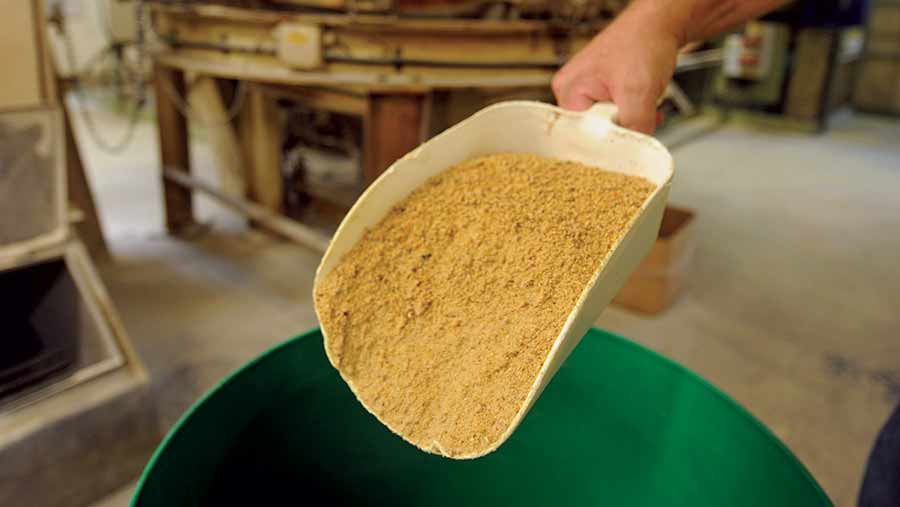How to meet the nutritional needs of broilers
 DO NOT REUSE
DO NOT REUSE Providing the correct combination of nutrients and assuring the quality of the feed are essential for good growth in broilers, writes Leonardo Linares, technical services nutritionist for broiler breeding firm Aviagen.
Broiler feeds are formulated, by the means of least cost formulation, to supply all the nutrients a bird needs for its maintenance and growth.
The feed on offer is made up of many components, including water, energy (provided by the metabolism of fat, protein, carbohydrates, sugars and fibres), vitamins and minerals, as well as non-nutritive additives, such as enzymes and medication.
See also: Managing the modern broiler – days seven to 21
In particular, the diet must provide the essential nutrients (nutrients that the birds cannot synthesise on their own, for example lysine and other amino acids), needed to optimise breast yield, and a range of other amino acids for things such as feather cover, feed conversion ratio and weight gain.
Changing needs
As the bird grows, so the daily energy demand increases because the maintenance requirement increases in line with body mass.
But this upturn in feed intake exceeds the potential for the bird to produce lean meat.
So, while the absolute daily requirement for protein increases, the dietary amino acid concentration needs to be reduced to prevent the overconsumption of protein.
Skeletal development is another important consideration.
Broiler growth is very fast in the starter and grower periods such that, by day 17, the birds weigh almost 16 times their initial chick weight.
To support good skeletal development, sufficient minerals, especially calcium (Ca) and phosphorous (P), and Vitamin D3 should be supplied by the diet. A ratio of Ca to available P of 2:1 should be provided.
After the skeleton has been completely formed – from 22-25 days – the mineral inclusion can be reduced.
But, with the addition of phytase enzymes to many modern diets (to release bound P from the raw materials), special attention must be paid to maintaining the ideal Ca to available P ratio, if skeletal development and maintenance issues are to be avoided.
All these factors make recommending a single feeding programme for broilers extremely difficult.
As such, all feed recommendations must be considered as a guide only, which may need to be adjusted according to local conditions, target market and ability of the feed mill to produce a variety of diets.
Feed quality
The quality of the feed must be assured from the point of raw material arrival at the mill until it reaches the feeder in the broiler house.
For that, a rigorous quality control programme must be in place at the feed mill, including:
- Physical and analytical verification of the quality of raw materials upon arrival
- Proper storage of raw materials
- Accurate weighing, grinding, mixing and pelleting processes
- Proper storage of the final product
- Ideal conditions of delivery to the farm, avoiding any contamination or reduction in physical quality
- When the feed arrives at the farm, it must be properly stored to prevent access by insects, rodents and other animals.
It must be protected from heat, moisture and light which will reduce feed quality.
The feeding system and equipment must be of high quality and well maintained in order to avoid deterioration at the point of consumption.
The feed presented to the birds should have as high a percentage of pellet/crumbs in it as possible, and a low level of fine particles.
In a free choice particle size preference test, it was noted that broilers went for larger feed particle sizes, of over 0.86mm from zero to 10 days of age.
This continues as they grow older and, from days 11 to 14, it was observed that birds prefer a particle size between 2mm and 4.76mm (see table below, left).
Above 14 days, a particle size of above 3mm should be fed.
Particle size choice of broilers between 11 and 14 days of age |
||||
|
Particle size |
< 2.00mm |
2.00-3.20mm |
3.20-4.76mm |
>4.76mm |
|
Preference |
21% |
43% |
34% |
2% |
Pellets or mash?
When comparing pellets against mash for broilers, Aviagen research showed that feeding a mash has a negative effect on feed intake, liveweight gain and feed conversion, with a loss in revenue estimated at 2p/bird at 35 days.
Pellets, on the other hand, offer a number of benefits, including:
- Decreased feed wastage
- Reduced selective feeding
- Decreased ingredient segregation
- Increased bulk density of the feed
- Reduced time and energy expended on feeding
- Elimination/reduction of micro-organisms in the feed
- Thermal treatment of starch and protein
- Deactivation of some anti-nutritional factors
- Improved palatability
- Better flow rates in automatic, on-farm feeding systems.
Conclusions
Diets should be formulated to provide all the essential nutrients required for production targets to be achieved.
Genetic progress has produced high yielding broilers which respond positively to increases in dietary amino acids.
But in order to achieve potential, birds must receive feeds made of good quality raw materials.
The feed manufacturing process should be well managed and controlled, and good feed quality should be maintained from the end of the pelleting process until it is presented to the birds in the shed.
